2011.01.25 16:19
what is our current architectural style called
The groupings simply came about by sorting the digital images I've accumulated over the years into a strict chronological order. More often than not I was surprised by what buildings are closely coeval. Certainly not the way I was used to seeing 'history'.
Is the result of Zeitgeist indeed now best described as collage?
2012.03.30 15:33
Response to Donna, re: Traditional Architecture
Coincidently read these two paragraphs a few hours ago...:
Having no faith in the efficacy of any single, universal, world transforming principle, Whitehead's obsevation that there is no reason to suppose order more fundamental than chaos would seem to appoximate his [ie, a famous architect] view; and this feeling for the empirical multiplicity of any given situation rather for any cosmic vision of a millennium also carries over into what seems to be anxiety to emancipate architecture from the grip of historicism--meaning not from the styles but from the very Germanic supposition that history, irrespective of persons, is an irresistible force, that obedience to it a moral imperative, that to deny the Zeitgeist is to invite catastrophe, and that the architect's most elevated role is to act as no more than the agent of necessity, as midwife for the delivery of historically significant form.
Given the arguments of reasoned disbelief, the procedure via collage and innuendo is, in principle, not to be faulted, but, if it is a procedure which can produce the most enviable results and also a genuinely Twentieth-Century discovery, the idea of the ironical juxtaposition of things taken out of context has, in general, been profoundly antipathetic to the conscience of the so-called Modern Movement; and, even though Le Corbusier was himself a great master of the architectural collage, the general bias of the contemporary architect's "morality" has contrived to inhibit the use of any technique so obvious and so rewarding.
2012.08.28 20:59
The Philadelphia School, deterritorialized
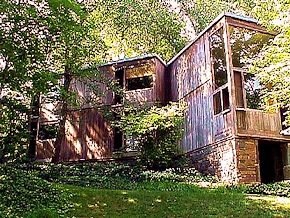
Spent a good part of this morning taking pictures around the exterior of Louis Kahn's Fisher House, in Hatboro, PA. Just by chance I found out last Friday that the house is currently on the market (and may actually be sold at this point), and the house is presently vacant. The exterior of the house is very nicely detailed, and still inspiring. It's also the plan of this house that inspired a collage technique I employ from time to time.
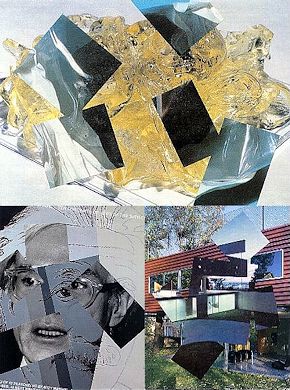
| |
2012.10.31 11:43
atemporality at work?
Do precedents and/or antecedents work against the notion of atemporality?
As much as I like the collages of Archive of Affinities, I am, at the same time, not prepared to fully explain why I like them nor what it is exactly about the collages that I like so much. Varnelis' description of the collages as "atemporality at work" is indeed intriguing, and I want to know more. Consequently thinking for myself, it is the search for and research of the precedents and antecedents that provide a context for a better understanding of the collages of Archive of Affinities.
Anecha, a fellow admirer of the collages of Archive of Affinities, feels the "recent work may not be postmodern in the design sense, in the sense of a particular style, it is explicitly postmodern in methodology and ideology. Postmodernism didn't stop because people stopped believing in it: as Lethem notes, 'the tools that postmodernism left us have entered mainstream usage, they are free to become distinct from any style.' Ultimately postmodernism is the framework in which creators have been, and are still operating." I suppose the question is: How do these new collages from Archive of Affinities operate? And from what context do they operate?
Interestingly, the words a-temporality and a-temporal make an appearance within the text of Collage City:
"Presented with Marinetti's chronolatry and Picasso's a-temporality; presented with Popper's critique of historicism (which is also Futurism/futurism); presented with the difficulties of both utopia and tradition, with the problems of both violence and atrophy; presented with alleged libertarian impulse and alleged need for the security of order; presented with the sectarian tightness of the architect's ethical corset and with more reasonable visions of catholicity; presented with contraction and expansion; we ask what other resolution of social problems is possible outside the, admitted, limitations of collage. Limitations which should be obvious enough; but limitations which still prescribe and assure an open territory."
"Excursus: We append an abridged list of stimulants, a-temporal and necessarily transcultural, as possible objets trouvés in the urbanistic collage."
...the Basilica of St. Stefano, Bologna, thirteenth century, a religious compound where the Court of Pilate and the Church of the Holy Sepulcher, Jerusalem were/are specifically reenacted.
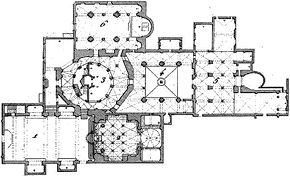
1. The six churches of which the plans are here given, nos. 1 to 6, are thus grouped at Bologna, under the title St. Stephen, the church no. 1, however, being more particularly dedicated to the saint.
2. Subterranean Church of S. Lorenzo, beneath that of St. Stephen, and serving as the Confession.
3. Church of the Holy Sepulchre; according to tradition the baptistery of St. Peter and St. Paul, no. 6, the first cathedral built at Bologna.
4. Another church, called the Court of Pilate.
5. Church of the Trinity.
6. Church of St. Peter and St. Paul.
| |
COLLAGE/DANIEL LIBESKIND. Collage challenges the notion of architecture as a synthetic construct--a mixture of various creative disciplines. The idea of achieving such a synthesis by a hollow manipulation of heterogeneous elements can result only in 'synthetic flaws'. Architecture cannot compete with film, total theater, technology, psychology, or sociology, to achieve relevance. By drawing from these motley disciplines it constructs only hybrid conglomerations without integral syntactic necessity or organic unity. The expedient definition of architecture as a 'total environmental system' is popular among designers, users, producers, critics, etc., because it allows the concurrence of all these points of view without provoking a conflict between them. The theory that architecture is a synthesis along Wagner's theory of the theater, allows and in turn justifies, the complete exploitation of any devise; be it plastic, programmatic, or technical, in order to achieve a superficial stimulation of our sensibilities. In this way the accidental and arbitrary parade in the guise of a new methodology. The attempt at incorporating these foreign technologies or sophisticated mechanizations does not lead to dynamism of thought but rather to enervating physical mobility. Progress in this direction is therefore futile from the conceptual view, for no matter how much architecture exploits these resources, it will always remain inferior to a discipline such as film, for its ability to manipulate sequences, control speed, or create instantaneousness. The analytic approach, devoid of multiple means, limited to the existing materials, determined by historical realities, can fashion a new framework for concepts and ideas by releasing us from the determinism in both syntactic and semantic domains. It is a kind of poverty that is being proposed. A poverty of matter to be compensated by the development of the conceptual ideal. The use of 'garbage' reveals a possible method which can penetrate beyond the surface appearance of meaning and form, and strike at the very depth of conditioned relations; generating through a new grammar radically different ways of perceiving, thinking, and ultimately perhaps acting. [c 1969]
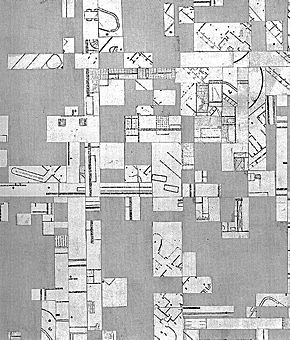
| |
Exodus, or the Voluntary Prisoners of Architecture
This study describes the steps that will have to be taken to establish an architectural oasis in the behavioral sink of London.
Suddenly, a strip of intense metropolitan desirability runs through the center of London. This strip is like a runway, a landing strip for the new architecture of collective monuments. Two walls enclose and protect this zone to retain its integrity and to prevent any contamination of its surface by the cancerous organism that threatens to engulf it.
Soon, the first inmates beg for admission. Their number rapidly swells into an unstoppable flow.
We witness the Exodus of London.
The physical structure of the old town will not be able to stand the continuing competition of this new architectural presence. London as we know it will become a pack of ruins.
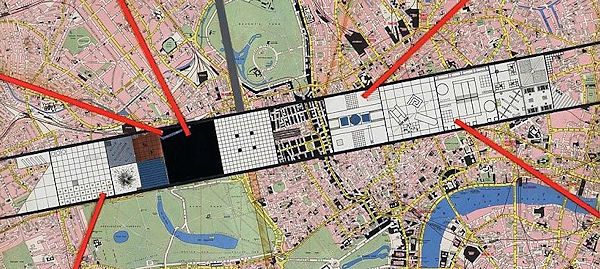
Rem Koolhaas, Madelon Vreisendorp, Elia Zenghelis, Zoe Zenghelis, 1971.
2012.11.05
Collage City collage
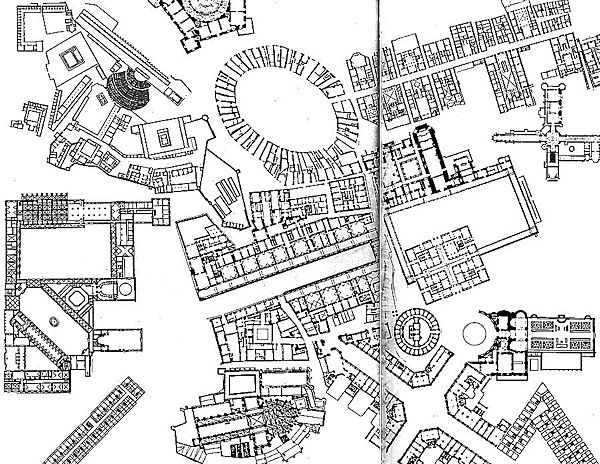
|